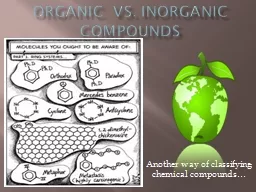

Another way of classifying chemical compounds Organic Compounds In science organic compounds contain carbon C and usually hydrogen H Carbon has four electrons in its valence shell which allows for more chemical bonding possibilities than any other element ID: 616178
Download Presentation The PPT/PDF document "Organic vs. Inorganic Compounds" is the property of its rightful owner. Permission is granted to download and print the materials on this web site for personal, non-commercial use only, and to display it on your personal computer provided you do not modify the materials and that you retain all copyright notices contained in the materials. By downloading content from our website, you accept the terms of this agreement.
Slide1
Organic vs. Inorganic Compounds
Another way of classifying chemical compounds… Slide2
Organic Compounds
In science, organic compounds contain
carbon (C), and usually
hydrogen
(
H)Slide3
Carbon has four electrons in its valence shell, which allows for more chemical bonding possibilities than any other element.Slide4
Inorganic Compounds
Inorganic compounds
do not contain carbon with 2 exceptions:Carbon Monoxide and
Carbon Dioxide
Compounds containing
carbonate (
CO
3
2-
) ionsSlide5Slide6
Organic or Inorganic
Octane
C
8
H
18
Starch
(C
6
H
10
O
5
)n
Carbon DioxideCO2 Methane CH4 Neon Ne Sodium Na Lactose (milk) C12 H 22 O11 Ethyl alcohol C2 H5 OH Steroid C27 H46 Hydrogen peroxide H2O2 Propane C3 H 8 Carbon monoxideCO Fructose (fruit) C6H12O6 Ammonia NH3 Wax C25H52 Sodium Chloride NaCl Sand SiO2 Sucrose C12H22O11 Water H2O SeashellsCaCO3 Cellulose (wood) (C6H10O5 )n Drano KOH Glucose C6H12O6
Organic
Organic
Inorganic
Organic
Inorganic
Inorganic
Organic
Organic
Organic
Inorganic
Organic
Inorganic
Organic
Inorganic
Organic
Inorganic
Inorganic
Organic
Inorganic
Inorganic
Inorganic
Organic
OrganicSlide7
A hydrocarbon is an organic compound that contains only carbon and hydrogen.
Hydrocarbons are based on a carbon chain, with hydrogen atoms added on the sides.
See pages 246 - 247Slide8
The simplest hydrocarbons are ones that you might recognize and have even used!
Methane (CH4)--- main component of natural gas
Ethane (C2H6)---
also found in natural gas
Propane (C
3H8) ---
used as a fuel for BBQs
Butane (C
4
H
10
) --- an extremely flammable
fluid used in industrial torches
Pentane (C
5
H12)---a liquid used to make fuelFormula CnH2n+2All hydrocarbons are flammable, and most are liquids are room temperatureSlide9
Alcohols are organic compounds with C, H, and O.
Alcohols are very good solvents (they dissolve other substances).
Alcohols are generally very flammable.
See pages 246 - 247
Organic CompoundsSlide10
Organic Compounds
The simplest alcohols are: Methanol (CH4
O)--- used in labs as a solvent
but causes
blindness!
Ethanol (C
2
H
6
O)---
is a psychoactive drug (present in alcohol), but is now being considered as a fuel source
Isopropyl alcohol (C3H8
O)---
rubbing alcohol used to sterile cuts
Alcohols are generally very flammableSlide11
Three different representations:
Structural formula
- lists the elements and their proportions in the order they are bondedShortened Structural Formula
Molecular Formula
Methane
Methanol
Acetic Acid (Vinegar)
CH
4
CH
3
OH
CH
3
COOH
CH3CH3C2H4O2 C2H6CH4OSlide12
Three different representations:
Space-filling model- similar to a ball-and-stick model, but an animated model that shows how elements are connected
Heme
- the iron-containing component of hemoglobin, C
34
H
32
FeN
4
O
4
Methylisocyanate
- a valuable synthetic component for biology CH
3
N=C=S